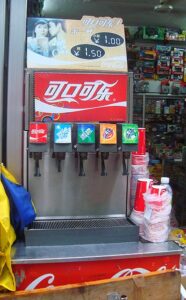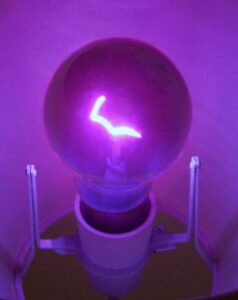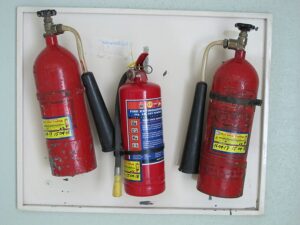In this article “Real gas examples” and real gas examples related which circumstances will be summarized. Real gas examples are does not follow the law of gases. Real gas examples works in low temperature.
8+ Ideal Gas Examples are listed below,
- Soda fountains
- Cable TV and WiFi
- Light bulbs
- Bakery products
- Hot air balloon
- Opening of a soda bottle
- Fire extinguisher
- Paintball
Soda fountains (Carbon dioxide):-
The soda fountains is a machine device by which we can get carbonated soft drinks, this types of drinks called fountain drinks. The soda fountains devices are now available in everywhere almost from start to restaurants it easily available in local markets. In the soda fountains machines syrup concentrate or flavoured syrup is mix up with purified and chilled water, carbon dioxide.
With taking the help of soda gun the drinks can easily can out from the device. Now bag in box soft drinks are kept in the soda fountains device. The carbon dioxide one of the most soluble gas substance among the all toxic gases thus carbon dioxide is the appropriate gas for preserve the drinks.

Image Credit – Wikimedia Commons
Cable TV and WiFi (Helium):-
In cable TV and WiFi connection real gas is use. In telecommunications, cable internet or cable internet access helium gas is use. Now a day uses of internet by help of cable lines gives lots of development and advancement of our busy schedule.

Image Credit – Wikimedia Commons
Benefit of Cable TV and WiFi:
- Reliable
- Admirable service
Light bulbs (Argon):-
Inside the light bulbs argon gas is used. The light bulb mainly depends on the working principle of incandescence. The meaning the incandescence is the light bulbs make light when heat is produced.
When in a thin metal filament of light bulb electric current is flows that time the filament getting heat and after heated it start to glow and in this way light is produce. In the light bulb filaments are made of tungsten because this metal have higher melting point compare to other metal.

Image Credit – Wikimedia Commons
Bakery products (Carbon dioxide):-
In bakery products carbon dioxide is used. In bakery products such as pies, rolls, breads, muffins and pastries sodium bicarbonate is uses. When the sodium bicarbonate mixes up with the products of bakery that time carbon dioxide is produce.

Image Credit – Wikimedia Commons
Hot air balloon (Hydrogen and Helium):-
Hot air balloon is lighter than the air craft. The hot air balloons have a big size balloon which is named envelope which has heated air. Inside the hot air balloons hydrogen and helium gas are present. A basket is present in it.

Image Credit – Wikimedia Commons
Opening of a soda bottle (Carbon dioxide):-
In a soda bottle compressed carbon dioxide is uses. The main reason behind using the carbon dioxide inside the bottle is this is the most non toxic gas. The fizz that bubbles up when we crack open a can of soda is carbon dioxide gas CO2. The industrial who make the soft drinks add this tingling froth by forcing carbon dioxide and water into your soda at high pressures—up to 1,200 pounds per square inch.
Fire extinguisher (Carbon dioxide):-
A fire extinguisher which is a device works as a safety device. Inside the fire extinguisher carbon dioxide is placed. It is used to control small size fire thus a big accident can be prevented.

Image Credit – Wikimedia Commons
In general two types of fire extinguisher are available. They are,
- Stored pressure fire extinguisher
- Cartridge operated fire extinguisher
Paintball (Nitrogen and carbon dioxide):-
The paintball is a comparative and very fun game. The purpose of the game is to hit a target object with the help of paintball. The gelatine shells are used to make paintballs. Inside the paintball carbon dioxide and nitrogen is placed. Inside the paintball carbon dioxide and nitrogen took place as liquid but when the trigger is pulled that time carbon dioxide and nitrogen under high pressure change its state and became gas.

Image Credit – Wikipedia
Frequent asked questions:-
Question: – What are the properties for the real gas.
Solution: – Real gas isa gaseous matter which are work in higher pressure and lower temperature. In our surroundings real gas are present. Real gases not follow gas law at any particular temperature or pressure.
The properties for the real gas is given below,
- When the real gas is comes across the porous plug that time the real gas passes high pressure to the comparative low pressure, for this particular reason temperature is changes.
- Real gas substance can be liquidities. The reason behind of it the molecules of the real gas have a physical property that is intermolecular attraction by which molecules can coalesce.
- The thermal expansion coefficient is depending upon the character of the real gas molecules.
- The compressibility coefficient is depending upon the character of the real gas molecules.
- Intermolecular attraction is present in the real gaseous substance. When the real gaseous substance is expanding the particles of the real gaseous substance have more kinetic energy to defeated intermolecular attraction and the temperature is changed.
- When the temperature of the real gaseous substance is under the critical temperature that time the molecules of real gaseous substance can liquefied under particular temperature and pressure.
Question: – Explain the coefficient of thermal expansion for gas.
Solution: – Thermal expansion actually a physical condition of substance to change its area, shape, density and volume under changing of temperature. Thermal expansion is not including the phase transitions. The S.I unit of the thermal expansion is per Kelvin.
The equation for thermal expansion coefficient is,
Where,
α = Coefficient of thermal expansion for gaseous matter
V = Volume for gaseous matter
T = Temperature for gaseous matter
P = Pressure for gaseous matter
For particularly 1 mole ideal gaseous substance PV = RT,
Where,
α = RP/V = 1/T

Image Credit – Wikipedia
Types of thermal expansion:
The thermal expansion can be divided in three sections,
- Linear expansion
- Area expansion
- Volume expansion
Linear expansion:-
Linear expansion can be explained as, changing of length due to temperature.
Linear expansion can be written as,
Where,
ΔL = Changing in length
L0 = Original length
α= Length expansion coefficient
L = Expanded length
ΔT= Temperature difference
Area expansion:-
Area expansion can be explained as, changing of area due to temperature.
Area expansion can be written as,
Where,
ΔA = Changing in area
A0 = Original area
α = Area expansion coefficient
A = Expanded area
ΔT= Temperature difference
Volume expansion:-
Volume expansion can be explained as, changing of volume due to temperature.
Volume expansion can be written as,
Where,
ΔV = Changing in volume
V0 = Original volume
α = Volume expansion coefficient
V = Expanded volume
Δ T= Temperature difference
Question: – Explain the coefficient of compressibility for gas.
Solution: – The coefficient of compressibility for gaseous matter is decreasing the amount of volume in per unit volume created by per unit change in pressure.
Read more about Thermal diffusivity : Its’s all important Facts and FAQs
Mathematically coefficient of compressibility written as,
Where,
β = Coefficient of compressibility for gaseous matter
V = Volume for gaseous matter
P = Pressure for gaseous matter
T = Temperature for gaseous matter
Coefficient of compressibility (β) for ideal gases,
Therefore, β should be a function of pressure only and the same for all gases. But experimentally the coefficient of compressibility has been found to be individual property
Question: – Explain the compressibility factor equation for gas.
Solution: – With the help of compressibility factor equation for gas we can understand reach of deviation of real gaseous substance from ideal gaseous substance character.
The compressibility factor equation for gas is,
Z = PV/RT
Where,
Z = Compressibility factor constant for gaseous substance
P = Pressure for gaseous substance
V = Volume for gaseous substance
R = Gas constant for gaseous substance
T = Temperature for gaseous substance
Read more about Pressure vessel design : It’s important facts and 5 parameters
Now, when the value of Compressibility factor constant for gaseous substance
Is equal to 1 (Z = 1) that time no deviation is present from the ideal gaseous substance behaviour.
Now, when the value of Compressibility factor constant for gaseous substance
Is not equal to 1 Z ≠ 1 that time the value of the unit for Z is measure for reach of non ideality.
When the value of Compressibility factor constant for gaseous substance
Is greater than 1 (Z < 1) that time the ideal gaseous substance will be more compressible.
When the value of Compressibility factor constant for gaseous substance
Is less than 1 (Z > 1) that time the ideal gaseous substance will be not more compressible.
Read more about Specific Enthalpy : Its important properties & amp; 8 FAQ’s
Question: – The difference between real gas and ideal gas describe.
The major points are derive about the difference between real gas and ideal gas,
| Parameter | Ideal gas | Real gas |
| Definition | The gas which are follow the law of gas at particular condition of constant pressure and temperature | The gas which are not follow the law of gas at particular condition of constant pressure and temperature |
| Formula | The formula which ideal gas is follow, PV = nRT Where, P = Pressure V = Volume n = Amount of substance R = Ideal gas constant T = Temperature | The formula which real gas is follow, Where, P = Pressure a = Parameter which need to determine empirically for individual gas V = Volume b = Parameter which need to determine empirically for individual gas n = Amount of substance R = Ideal gas constant T = Temperature |
| Availability | Not exist | Exist |
Hi..I am Indrani Banerjee. I completed my bachelor’s degree in mechanical engineering. I am an enthusiastic person and I am a person who is positive about every aspect of life. I like to read Books and listen to music.